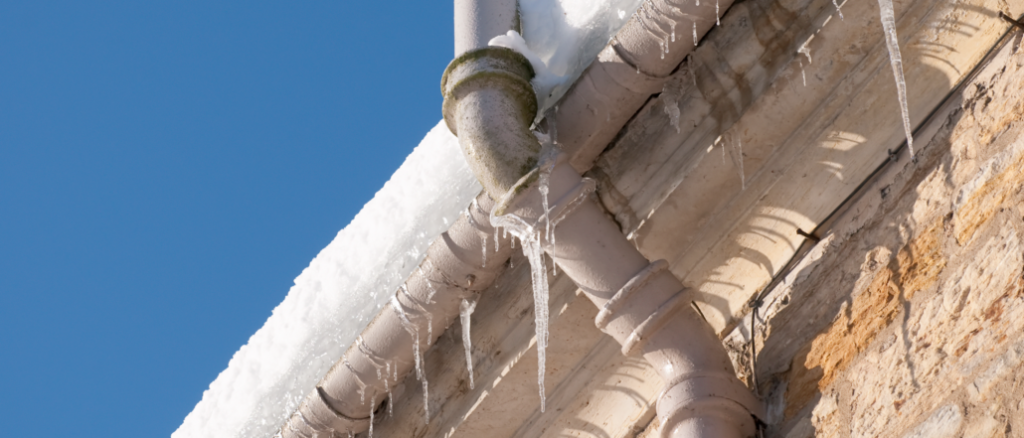How small businesses can minimize the risk of freeze damage

3 minute read
As the season of tornadoes and wildfires has now ended, small business owners must turn their attention to a new set of risks – ranging from blizzards and snowsqualls to ice storms, freezing rain, and cold snaps.
While winter storms often make the headlines, even a minor incident, like accidentally leaving a window open during fluctuating temperatures, can cause extensive damage to a building or property. For example, if water inside a pipe freezes, the ice can expand and put pressure on the pipe, causing it to crack or burst. And that can result in costly repairs and business disruption.
While we can’t do much to stop the onset of winter, we can prepare for exposures to mitigate weather-related risks.
How freeze damage could impact your business
Many Canadian small business owners are accustomed to winter weather, but freeze damage can be caused by accidents (such as leaving a window open) or disrepair (such as a crack in an exterior wall, or insulation around piping that has deteriorated). This is of particular concern when there’s a wild swing in temperature, where one day it’s -20°C, the next it’s above zero, before it plummets once again.
Freeze damage could cause pipes to crack, rupture, or burst, which could lead to costly mechanical or electrical repairs, potential safety hazards, and business interruption. For instance, if a pipe bursts, that may require you to shut down the water supply for several days, or cause extensive water damage to the interior and/or exterior of your building or property. Also, if the sprinkler system is damaged, this could cause it to malfunction during a fire emergency.
Analyze your freeze hazards
The first step in mitigating the risks of freeze damage is being aware of your site-specific freeze exposure and how it could potentially impact your business operations. For example, do you have pipes in a drafty storage room that could be vulnerable during a deep freeze?
At the onset of winter, assess the condition of your building or property. Make sure the heating system is operating properly and do any routine maintenance, such as sealing cracks and holes, or adding weather-stripping around doors and windows.
Identify any equipment, piping, or process systems that contain water or other liquids that could freeze. Don’t forget to check air instrumentation lines where freezing condensation could rupture the line or impact operations.
Examine pipes located near exterior walls; in poorly insulated attics, utility rooms, stairwells, or crawl spaces; and in any unheated areas such as storage rooms or warehouses. Also inspect insulation for signs of deterioration, especially on exterior pipes.
Check your roof drainage system, which should be kept free of ice build-up throughout winter to prevent ice damming.
Update your heating plan
Heating and insulation systems should be maintained at a minimum of 4.4°C. That includes spaces that could be vulnerable to freezing conditions, such as attics, corners, and crawl spaces. For example, a poorly insulated crawl space might have a piping system that’s difficult to heat in the winter. In this case, consider temporary interior openings that allow heat to circulate.
For piping that may be susceptible to freezing, consider using heat tracing or pipe insulation. Any existing heat tracing or pipe insulation should be inspected to ensure it’s in proper working condition.
In areas that are unheated — or where you can’t maintain heating above 4.4°C — drain all equipment that has water or is susceptible to condensation or freezing. Keep in mind that proper piping pitch and low point drains are critical to ensure complete drainage. If you’re unsure of how to do this, hire a professional.
Monitor vulnerable systems and spaces
While it’s important to assess the condition of your building or property before the onset of winter, it’s also important to conduct routine inspections throughout the season. Be sure to inspect exterior piping, areas that are hard to heat, and buildings that are unoccupied for extended periods of time (such as storage sheds).
If thermostats are located in warmer areas of a building, they may need to be set higher to ensure a minimum acceptable temperature in remote or concealed spaces. Ideally, thermometers or low temperature detection systems should be located in areas with critical equipment and piping. Thermometers with remote monitoring capabilities are particularly important in hard-to-access areas such as attics and crawl spaces. Infrared imaging can also be used to help identify areas with significant heat loss.
Be prepared for emergencies
As part of your emergency plan, ensure you have a backup heating source available, and be prepared to drain key equipment and piping if necessary. That means employees should be trained on how to shut off the main water supply in case of an emergency.
Your emergency supply kit should include antifreeze materials, approved portable heaters, tarpaulins for windbreaks, and ice control products. If you use portable heaters as a backup heating source, make sure they’re in good working condition with appropriate safety interlocks, and that the room or building that they’re in is properly ventilated.
Protect yourself and your business
No matter how much preparation you do in the winter months, sometimes things go wrong. That’s why having the right protection in place can make all the difference to you and your small business. To learn more about protecting yourself and your business, visit our Small Business Insurance Page today.
This blog is provided for information only and is not a substitute for professional advice. We make no representations or warranties regarding the accuracy or completeness of the information and will not be responsible for any loss arising out of reliance on the information.






